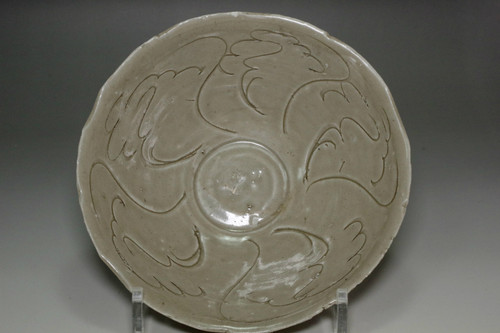12C-13C TONG'AN Kiln Celadon Bowl with Impressed Floral Patterns #5152
- SKU:
- 5152
- Shipping:
- Free Shipping
Width: approx. 17.2 cm (6 25/32 in)
Height: approx. 6.3 cm (2 31/64 in)
Weight: 350g
Condition: small chip in rim
Origin: Fujian, China
This bowl was made during the Southern Song dynasty at the Tong'an Kiln in Fujian Province, China, and its appeal lies in the following aspects.
First, the incised design on the interior of the bowl is striking. The freely drawn cloud-like curves create an elegant and delicate decoration, which is characteristic of the ceramics from the Southern Song period. The glaze has a soft luster, with a calm hue spread across the entire surface, evoking the warmth of handcrafted craftsmanship.
Moreover, this bowl is a valuable artifact from the Tong'an Kiln, which played a significant role in maritime trade during the Song dynasty. Tong'an Kiln is known for producing export ceramics, especially to East Asia, including Japan, making this bowl a potential symbol of cultural exchange during that era.
Its sturdy yet graceful form blends practicality and beauty, making it an exceptional piece for both collectors and tea ceremony enthusiasts, suitable for both display and practical use.
TONG'AN Kiln
The Fujian Tong'an Kiln was one of the prominent kilns in Fujian Province, China, active from the Song to the Ming dynasty, producing primarily celadon and white porcelain. The kiln developed particularly during the late Song and Southern Song periods, known for creating ceramics with glazes that became recognized in Japan as "JUKO Celadon". These products were highly valued by tea masters, such as Murata Juko, and played a significant role in the development of Japanese tea culture.
Located along the Fujian coast, the Tong'an Kiln was strategically positioned near Quanzhou Port, a major hub for maritime trade during the Song dynasty. The establishment of the Shibosi (Maritime Trade Office) in the Song dynasty facilitated the growth of the ceramic trade, leading to the kiln's further development and increased exportation of its goods to East and Southeast Asia.
The kiln's peak was during these centuries, but like many other ancient kilns, it eventually declined, likely during the later Ming dynasty as production shifted and other regions like Jingdezhen gained prominence.
















